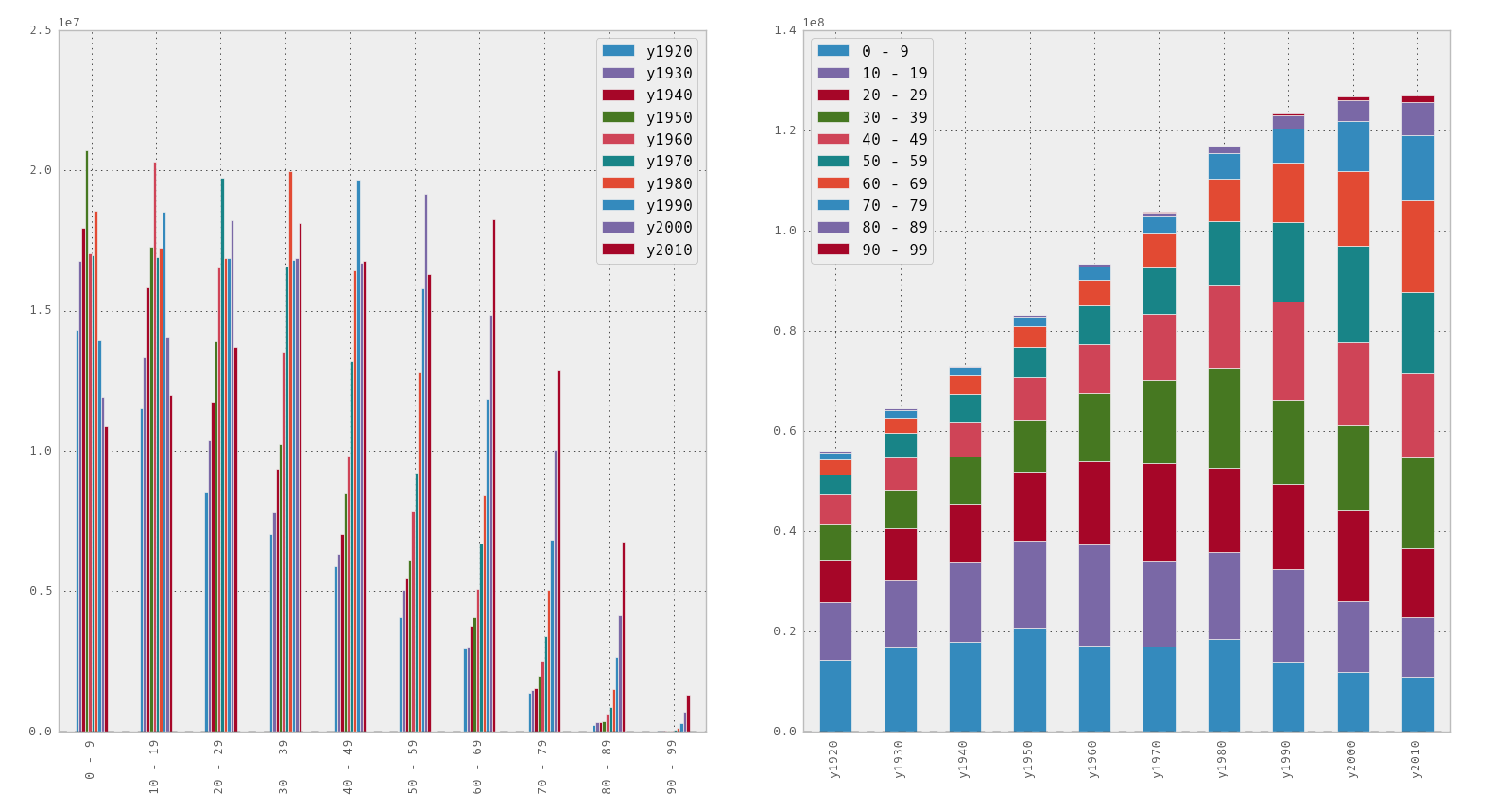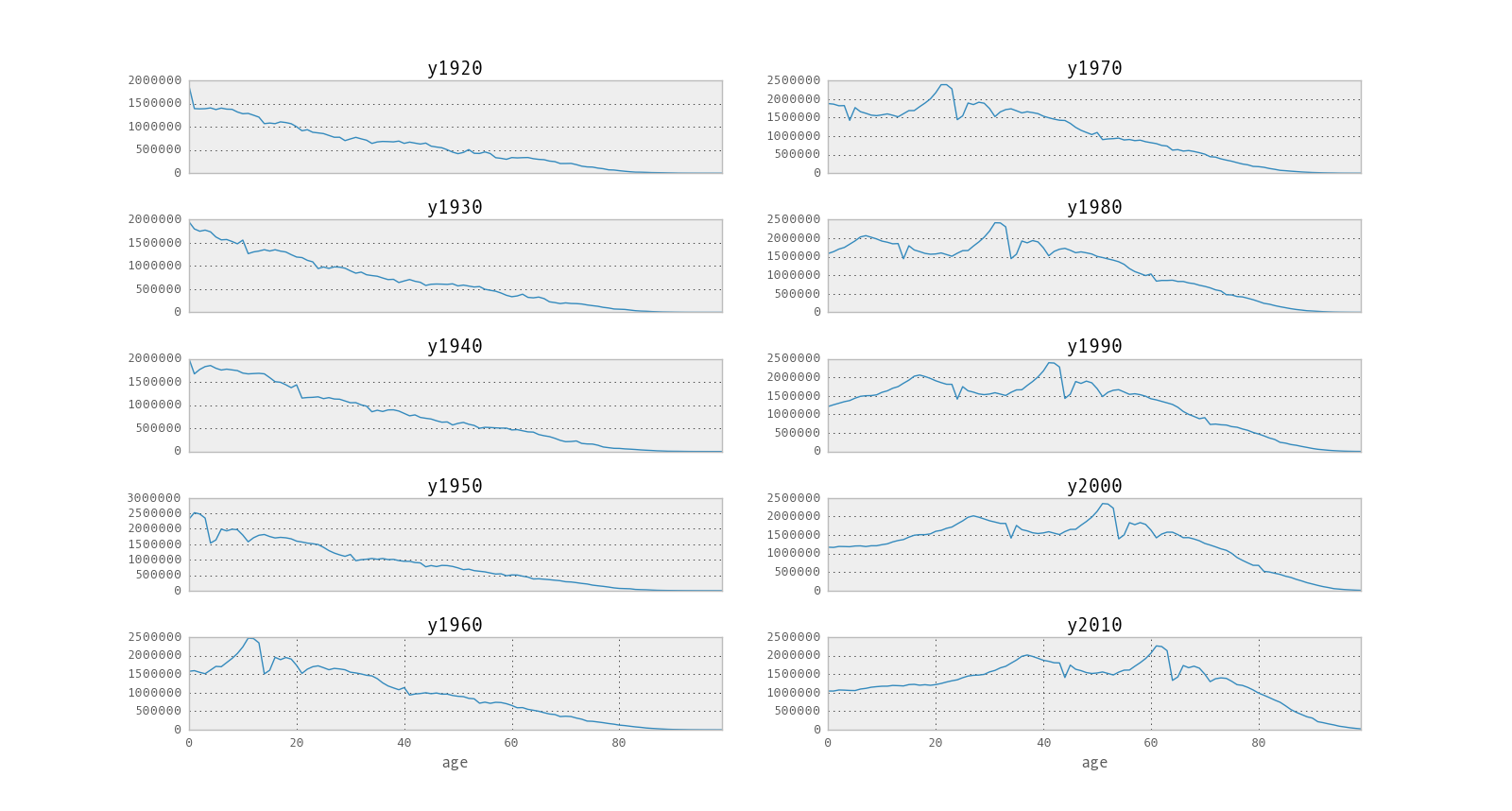1歳ごとに集計された値を10歳ごとにまとめます。
pandas の cut で階級を設定し、groupby で集計します。
- pandas.cut — pandas 0.15.1 documentation
- pandas.DataFrame.groupby — pandas 0.15.1 documentation
- Group By: split-apply-combine — pandas 0.15.1 documentation
データは総務省統計局が公開している「年齢別人口」のエクセルをCSV形式にしたものを使います。
- 統計局ホームページ/第六十四回日本統計年鑑 平成27年-第2章 人口・世帯
- → 2 - 7 年齢別人口(エクセル:42KB)
扱いを簡単にするために、データ上部の説明行と、下部の注意書きおよび「100歳以上」と「不詳」の行を削除しておきます。調整したファイルは population-by-age.csv とします。
pandas で処理
まずは numpy と pandas のモジュールを読み込みます。
IPython でグラフを描画する設定も追加しておきます。
import numpy as np
import pandas as pd
import matplotlib.pyplot as plt
pd.options.display.mpl_style = 'default'
CSVファイルを読み込みます。1列目をインデックスに指定します。
読み込んだらデータ型を確認しておきます。
df = pd.read_csv('population-by-age.csv', index_col='age')
print df.dtypes
y1920 int64
y1930 int64
y1940 int64
y1950 int64
y1960 int64
y1970 int64
y1980 int64
y1990 int64
y2000 int64
y2010 int64
dtype: object
その他に、先頭と末尾、統計量を確認しておきましょう。表示は省略します。
print df.head(3)
print df.tail(3)
print df.describe()
cut を使って階級を設定します。
階級幅を変更したい場合は range の第3引数を調整してください。階級の両端を含む・含まないはオプションで指定します。 include_lowest と right オプションを適宜切り替えてください。
labels は表示用の文字列を設定します。数学的な閉区間・開区間の表現の方が分かりやすい場合は未指定で構いません。
labels = [ "{0} - {1}".format(i, i + 9) for i in range(0, 100, 10) ]
c = pd.cut(df.index, np.arange(0, 101, 10),
include_lowest=True, right=False,
labels=labels)
print df.groupby(c).sum()
y1920 y1930 y1940 y1950 y1960 y1970 y1980
0 - 9 14314635 16778220 17961607 20728122 17049068 16965066 18547450
10 - 19 11520624 13340649 15816378 17267585 20326076 16921989 17231873
20 - 29 8533259 10367140 11756837 13910662 16527810 19749434 16882381
30 - 39 7020188 7798498 9370143 10250310 13555835 16578939 19973312
40 - 49 5902331 6332741 7041270 8487529 9835689 13217564 16427887
50 - 59 4074855 5046797 5446760 6137697 7842597 9230197 12813527
60 - 69 2968342 2977915 3782574 4074610 5092019 6709761 8429928
70 - 79 1378630 1478319 1541314 1967261 2518482 3401952 5059662
80 - 89 236419 315624 338472 354836 638738 879221 1503633
90 - 99 13657 13997 18567 16258 32043 65629 118391
y1990 y2000 y2010
0 - 9 13959454 11925887 10882409
10 - 19 18533872 14034777 11984392
20 - 29 16870834 18211769 13720134
30 - 39 16791465 16891475 18127846
40 - 49 19676302 16716227 16774981
50 - 59 15813274 19176162 16308233
60 - 69 11848590 14841772 18247422
70 - 79 6835747 10051176 12904315
80 - 89 2665908 4147012 6768852
90 - 99 286141 688769 1318463
ということで、1歳ごとに集計された値を10歳ごとに集計できました。
集計関数は sum 以外にも指定できますし、複数を指定することも可能です。
以下の結果を確認しておきましょう。
print df.groupby(c).agg(['count', 'min', 'max', 'mean', 'std'])
グラフ描画
上述の数字だけだと関係性が分かりにくいので、グラフにして数の概況を把握します。
描画するときの stacked オプションを比較するために並べて配置してみます。
fig, axes = plt.subplots(ncols=2)
df.groupby(c).sum().plot(kind='bar', ax=axes[0])
df.groupby(c).sum().T.plot(kind='bar', stacked=True, ax=axes[1])
10歳ごとに並べてみると、最近になるほどに60歳以上の人口が増えています。一方で、若年層の人口は減っていることが分かります。積み上げグラフにしてみると、1920年から2000年までは順調に人口が増加していますが、2010年にかけては減少していることが分かります。世代分布としても、グラフの棒の上部の比率が増えています。
集計してだいたいの傾向は分かりましたので、元のデータフレームの各系列を描画します。単にプロットするとゴチャゴチャとしますので、それぞれの年ごとに別々のグラフとして描画してみます。今度は axes 変数は二次元になっていますので、配列インデックスを指定するときは注意しましょう。
fig, axes = plt.subplots(nrows=5, ncols=2)
for i, y in enumerate(['y1920', 'y1930', 'y1940', 'y1950', 'y1960']):
df[y].plot(ax=axes[i, 0])
axes[i, 0].set_title(y)
if y != 'y1960':
axes[i, 0].get_xaxis().set_visible(False)
for i, y in enumerate(['y1970', 'y1980', 'y1990', 'y2000', 'y2010']):
df[y].plot(ax=axes[i, 1])
axes[i, 1].set_title(y)
if y != 'y2010':
axes[i, 1].get_xaxis().set_visible(False)
個別のグラフを見てみると、ベビーブームの影響がよく分かります。また、第二次ベビーブーム以降は出生数が減っていることや、1970年以降は高齢者の裾野が広がっている(寿命が延びている)ことも見てとれますね。

